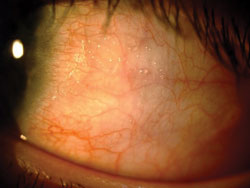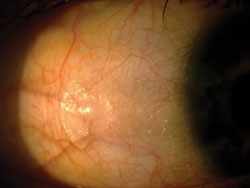Patient with glaucoma has symptomless spots on his conjunctiva
A 13-year-old white male was referred to our clinic by a glaucoma specialist for a second opinion on a conjunctival abnormality in both eyes. The patient had seen the glaucoma specialist for many years for congenital glaucoma and previously had successful glaucoma shunt surgery several years ago.
The patient was using Travatan (0.004% travoprost, Alcon) once daily in both eyes and Cosopt (0.5% timolol and 2.0% dorzolamide, Merck) twice daily in both eyes, with reported compliance. Intraocular pressures were within the target of mid-teens. His was on no systemic medications.
The glaucoma surgery and topical medicines were a secondary issue in this case. The reason for the visit was the spots on his conjunctiva. The patient reported that the spots on his eyes have been there as long as he can remember and they are symptomless.

Leo P. Semes
His best corrected visual acuities were 20/30 OD and 20/25 OS. These acuities were repeatable and stable. Intraocular pressures were 20 mm Hg OD and 17 mm Hg OS via Tono-pen (Reichert, Depew, N.Y.). The slit lamp examination revealed clean and clear lids and lashes. Conjunctival assessment showed raised plaques on the temporal bulbar conjunctiva with no limbal involvement in either eye. The patient also had functional filtering blebs in both eyes. Megalocornea resulting from his congenital glaucoma were present in both eyes. Otherwise, the cornea was of normal architecture and was clear with no opacities.
The iris was flat and intact with no obvious anomalies, with anterior chamber angles open (grade 4) to ciliary body band on four-mirror gonioscopy. The angles were also deep and quiet, with no obvious signs of inflammation.


The slit lamp examination revealed clean and clear lids and lashes in both eyes. Conjunctival assessment showed raised plaques on the temporal bulbar conjunctiva with no limbal involvement.
Images: Parker J
Dilated fundus exam was not performed at this visit, but a nondilated view was taken with a 90-D lens, demonstrating extensive cupping of both optic nerves of each eye consistent with congenital glaucoma.
What is your diagnosis?
Conjunctival spots
Differential diagnoses include exposure keratitis, Stevens-Johnson syndrome, Sjögren’s syndrome, excessive frothy tear production, pinguecula, conjunctival intraepithelial neoplasia, or bitot spots secondary to vitamin A deficiency. All of these conditions are applicable to all age groups.
Exposure keratitis may result from any process that causes inadequate eyelid closure. Clinical features range from symptomless to foreign body sensation, itching, burning, decreased vision, pain or light sensitivity. Clinically, best visualization will occur with a corneal/conjunctival staining dye such as rose bengal, lissamine green or sodium fluorescein. This patient was free of conjunctival staining.

Amber Christie Zaunbrecher
Stevens-Johnson syndrome is a type of hypersensitivity reaction of the mucous membranes that occurs in response to medications, infections or illness. The patient typically develops a fever, itching, joint aches and multiple skin lenses. It is a medical emergency that can lead to a lifetime of complications. Treatment focuses on eliminating the offending agent and gaining control of the symptoms and complications. With the conjunctiva being a mucous membrane, a lifetime of dryness, redness and uncomfortable irritation could follow. This was ruled out by lack of these medications.
Sjögren’s syndrome is a chronic autoimmune disease in which a person’s white blood cells attack the moisture-producing glands throughout the body. This misdirected immune response leads to inflammation of tissues. For the eye, the lacrimal gland is most directly affected, and tear production is decreased. Treatment is often directed at the production and retention of tears. No signs or symptoms of Sjögrens were observed.
Excessive frothy tear production would be characteristic of evaporative dry eye. The oil glands overproduce, and products undergo saponification, creating the frothy tear margin often seen primarily in the elderly population.
Pinguecula is a yellow or white lesion of abnormal or degenerative collagen manifesting in the subepithelial medial or temporal limbus. They are most prevalent in tropical climates and have a direct correlation to sun exposure. Although typically seen in individuals older than 40, they can present in earlier age groups who spend a significant amount of time in the sun. The mainstay of treatment is aimed at eliminating dryness caused by an irregular tear surface. The clinical appearance did not fit with this lesion.
Conjunctival intraepithelial neoplasia is a rare precursor of squamous cell carcinoma. It is typically unilateral and seen in fair-skinned, older individuals. These white, gelatinous masses are usually confined to the conjunctival epithelium but can break through to the underlying stroma during metastasis. Clinically, they appear as fleshy or frothy vascularized lesions in the intrapalpebral conjunctiva. Proper management includes a prompt referral for biopsy and probable excision.
Vitamin A deficiency is a disease that manifests itself on an ocular spectrum. Bitot spots are the beginning signs of a spectrum of dryness leading to a condition called xerophthalmia. This is a rare condition in developed countries but may occur in individuals with poor or impaired absorption of vitamin A.
In order to understand vitamin A deficiency, we need to first revisit the two classifications of keratoconjunctivitis sicca: aqueous or evaporative layer deficiency. Aqueous layer deficiency can then be subdivided into Sjögren’s or non-Sjögren’s. Within this subgroup of non-Sjögren’s, we will find vitamin A deficiency.
The patient was diagnosed with bitot spots and was recommended to begin vitamin A therapy.
Symptoms/signs
Bitot spots are accumulations of keratinized epithelial debris and secretions of the superficial conjunctiva. They are generally oval, triangular or irregular in shape. If left untreated, they can progress into xerophthalmia. Xerophthalmia affects about 8 to 10 million children worldwide younger than 5 years.
Symptoms can include anything from dry eye-like discomfort to night blindness to loss of vision. The conjunctiva appears dry throughout the interpalpebral zone. This is best visualized under both white and blue light with ocular dyes such as lissamine green and sodium fluorescein. The cornea may show epithelial erosions in the interpalpebral zone with keratinization.
Pathogenesis
The loss of goblet cells in the conjunctiva causes a disruption in the balance of the mucous membranes on the front surface of the eye. An accumulation of keratinized epithelial debris and secretions forms on the superficial conjunctiva. Xerophthalmia results from destructive dryness of conjunctival epithelium secondary to the lack of vitamin A. Squamous metaplasia and keratinization of the eye can cause eventual sterile conjunctival melting by liquefactive necrosis.
In the eye, vitamin A is essential for producing healthy epithelial surfaces, immune function and synthesis of retinal photoreceptor proteins. The lack of vitamin A leads to problems in both the ocular surface and the fundus, such as chronic dryness and night vision problems, respectively.
Risk factors include malnutrition, malabsorption, chronic alcoholism or a highly selective diet.
Treatment
There are two methods to approach treatment of xerophthalmia: the practitioner can treat the symptoms or treat the deficiency.
Treating the symptoms is similar to treating chronic dry eye. Increased artificial tear supplements, increase in humidity of indoor environments and wearing protective sunglasses outdoors are all current methods.
To truly treat the disease you must address the underlying issue of lack of vitamin A. A spectrum of treatment options are available based on the availability to the patient.
A subclinical deficiency can usually be controlled with a change of diet to include vitamin A-rich foods such as liver, beef, eggs, chicken, fortified milk, carrots, mangos and leafy green vegetables. In underprivileged countries or areas where a balanced diet is not available, therapeutic doses of vitamin A are given via injection. The dosages vary depending on age and severity. The optometrist involved should work with the primary care physician, pediatrician or nutritionist in supplemental management of the patient.
Resolution of the conjunctival bitot spots, night blindness and potential for vision loss will lessen as the appropriate levels of vitamin A are restored to the patients’ tissues.
This patient’s management
It was recommended that this patient receive vitamin A supplementation both through diet and injections on a regular basis. Despite this therapy, the patient’s conjunctival bitot spots did not resolve. The patient does not suffer with any dry eye complaints and reports overall comfort in his ocular tissues. Idiopathic conjunctival bitot spots still exist in his interpalpebral area to this day.
For more information:
- Amber Christie Zaunbrecher, OD, is a resident at the University of Alabama at Birmingham School of Optometry. She can be reached at 1716 University Blvd., Birmingham, AL 35294-0010; (478) 461-2960; aczaunbr@uab.edu.
- Edited by Leo P. Semes, OD, a professor of optometry, University of Alabama at Birmingham and a member of the Primary Care Optometry News Editorial Board. He may be contacted at 1716 University Blvd., Birmingham, AL 35294-0010; (205) 934-6773; fax: (205) 934-6758; lsemes@uab.edu.
